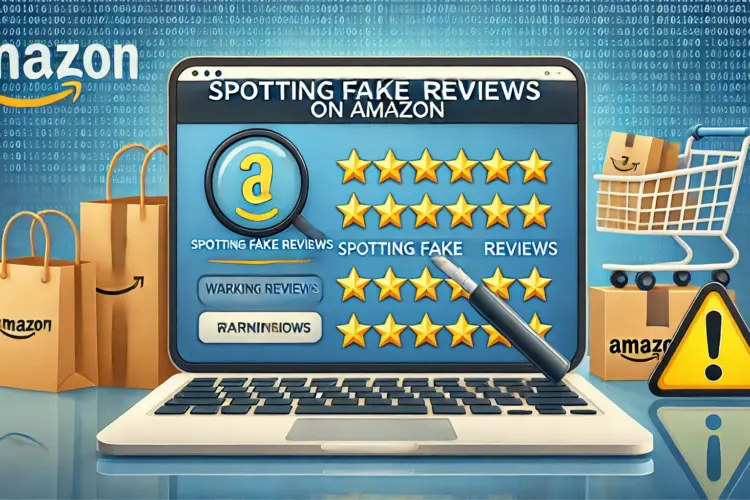
In today’s online shopping world, customer reviews can make or break a purchase decision—but not all reviews are what they seem. Fake reviews on Amazon are a growing issue, often designed to mislead shoppers with exaggerated praise or unfair criticism. These deceptive reviews can trick you into buying low-quality products or overlooking great ones. Fortunately, learning how to spot fake Amazon reviews is easier than you might think. In this guide, we’ll walk you through the telltale signs of fake reviews and share tools to help you shop with confidence.
Let’s dive into how you can protect yourself and make smarter buying choices on Amazon!
In today’s online shopping world, customer reviews can make or break a purchase decision—but not all reviews are what they seem. Fake reviews on Amazon are a growing issue, often designed to mislead shoppers with exaggerated praise or unfair criticism. These deceptive reviews can trick you into buying low-quality products or overlooking great ones. Fortunately, learning how to spot fake Amazon reviews is easier than you might think. In this guide, we’ll walk you through the telltale signs of fake reviews and share tools to help you shop with confidence.
Let’s dive into how you can protect yourself and make smarter buying choices on Amazon!
Why Fake Reviews Matter
Fake reviews aren’t just annoying—they can cost you time, money, and trust. Here’s why they’re a problem:
- Inflated Ratings: Paid reviewers might flood a product with five-star ratings, hiding its flaws.
- Competitor Sabotage: Negative fake reviews can unfairly tank a good product’s reputation.
- Wasted Purchases: Misleading feedback can lead you to buy items that don’t live up to the hype.
By knowing what to look for, you can cut through the deception and find reviews you can actually trust.
6 Signs of a Fake Amazon Review
When browsing Amazon reviews, watch for these red flags to spot fakes:
- Suspicious Reviewer History
- Check the reviewer’s profile by clicking their name. If they only review products from one seller or focus on a single category (like only kitchen gadgets), they might be a paid reviewer.
- Tip: A legit reviewer usually has a varied history of reviews across different products.
2. Vague or Over-the-Top Content
- Fake reviews often lack substance. Look out for short, generic praise like “Great product!” or excessive enthusiasm without details. Real reviews tend to mention specific experiences.
- Example: “This blender changed my life!” (fake) vs. “This blender purees smoothies in 30 seconds but struggles with ice” (genuine).
3. Unusual Review Timing
- A sudden spike of positive reviews—say, 15 five-star posts in a single day—can signal a coordinated effort to boost a product’s rating.
- Tip: Scroll through review dates to check for clustering.
4. No “Verified Purchase” Badge
- Amazon marks reviews from buyers with a “Verified Purchase” badge. While not a guarantee of honesty (some fakes slip through), it’s a good starting point.
- Note: Be extra cautious with non-verified reviews, especially if they seem off.
5. Lack of Detail
- Genuine reviews often include pros, cons, and specifics about how the product performed. Fake ones might be too brief or only focus on praise without balance.
- Tip: Trust reviews that are a few sentences long and mention real-world use.
6. Generic or Empty Reviewer Profile
- Click the reviewer’s name. If their profile lacks a picture, real name, or review history, it could be a throwaway account created for fake reviews.
- Tip: Authentic profiles often show personality and a mix of reviews.
Tools to Simplify the Process
Want a faster way to check reviews? These Amazon review checker tools analyze reviews for authenticity and give you a clearer picture:
- Fakespot: Paste an Amazon product URL into Fakespot, and it’ll grade the reviews based on trustworthiness, flagging suspicious patterns like fake reviewer behavior.
- ReviewMeta: This tool filters out questionable reviews and adjusts the product’s rating to reflect more genuine feedback. It’s perfect for double-checking big purchases.
Both are free, user-friendly, and take the guesswork out of spotting fake reviews.
How to Shop Smarter on Amazon
Armed with these tips, here’s how to put them into practice:
- Scan Multiple Reviews: Don’t judge a product by one or two reviews—look for consistent patterns across many.
- Prioritize Detailed Feedback: Focus on reviews that dive into specifics, like performance, durability, or quirks.
- Use Tools for Big Buys: For pricey items, run the reviews through Fakespot or ReviewMeta for extra peace of mind.
A little vigilance goes a long way toward avoiding buyer’s remorse.
Conclusion: Take Control of Your Shopping
Fake reviews may be sneaky, but they don’t have to fool you. By watching for signs like vague content, suspicious timing, and sketchy reviewer profiles, you can master how to spot fake Amazon reviews. Pair that with handy tools like Fakespot and ReviewMeta, and you’ll navigate Amazon’s review system like a pro.
Next time you shop, take a moment to dig into the reviews. You’ll save money and feel great about your purchases!
Get More Shopping Tips!
Love insider tricks like this? Sign up for our newsletter to get deal-hunting strategies, exclusive offers, and more delivered to your inbox!
Email Subject Line: “Don’t Get Fooled: Spot Fake Amazon Reviews Easily!”

0 Comments